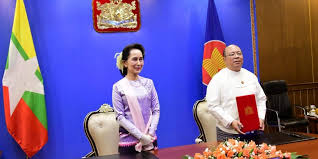Myanmar joins Regional Comprehensive Economic Partnership (RCEP) by Ministry of Investment and Foreign Economic Relations (MIFER)
3 ธันวาคม 2563
Myanmar joins Regional Comprehensive Economic Partnership (RCEP)
by Ministry of Investment and Foreign Economic Relations (MIFER)
Translated by
Nway Nway Htet
Business Information Centre (BIC)
Royal Thai Embassy, Yangon
The Regional Comprehensive Economic Partnership (RCEP) is a free trade agreement that had been negotiated among the group of 10 ASEAN member states and its 6 dialogue partners: China, Japan, South Korea, India, Australia and New Zealand
since 2012. However, India announced that it would no longer be participating in the RCEP negotiations due to the failure of the other 15 countries to comply with India Prime Minister Narendra Modi’s request on trade and investment issues at the Third RCEP Summit which was held in Thailand in November 2019. Therefore, 10 ASEAN member countries and 5 countries, China, Japan, South Korea, Australia and New Zealand continued the discussions until 2020 and have signed the RCEP.
There are around 2.2 billion people representing almost 30% of the world's population with a combined GDP of US $ 26.2 trillion, and producing about 30% of global GDP which is part of 28% of the global trade, that make the RCEP the world's largest free trade arrangement.
Discussion of RCEP agreement concentrated on (1) trade liberalisation through market access, and (2)negotiating principles in parallel. This began in 2012 and lasted for about eight years. During this period, there were four Summits attended by Heads of State, 19 regular and interim meetings of the Ministers, and several meetings of the Trade Negotiating Committee and Working Group were held in addition to several in-person meetings,as well as those via video conferences.
How can Myanmar get benefit from being a member of the RCEP?
RCEP agreement takes into account the different levels of development among the signatories, particularly Cambodia, Laos and Myanmar will enjoy more privileges than the other countries on tariff elimination.
The RCEP member countries will apply duty-free for 65%of products lines  at the time when the agreement takes effect, but the three countries (Cambodia, Laos, and Myanmar) will only need to abolish tariff by 30%. After ten years, the other countries will have to further eliminate customs tariff to 80% but Myanmar will be allowed to have 15 years to do so.
at the time when the agreement takes effect, but the three countries (Cambodia, Laos, and Myanmar) will only need to abolish tariff by 30%. After ten years, the other countries will have to further eliminate customs tariff to 80% but Myanmar will be allowed to have 15 years to do so.
Signatories was also agreed that the Least Developed Countries would consider the need to implement the commitments under this Agreement effectively and profitably in their efforts to be integrated intoregional and global production and value chains in order to further expand trade and investment opportunities.
For the commitments on e-commerce, intellectual property and competition policy, the nations agreed that the transition period for Myanmar should be from a minimum of three years to a maximum of 10 years. It also gives Myanmar a transition period of up to 15 years for those in trade sector. In the government procurement section, Myanmar will be exempt from the contractual obligations and will only need to abide by the agreement to cooperate on transparency.
As a member of ASEAN, Myanmar is committed to become a member of the modern and advanced RCEP. It will provide an opportunity to bring the framework and procedures in line with international standards, and to increase the capacity of the government and private sector organizations to meet such international standards.
In addition, the agreement will provide a market opportunity for Myanmar's exports to the developed countries such as Japan,South Korea, Australia, New Zealand and Singapore. Most of technologically advanced economies in Asia,such as Singapore, are subjected to terms and conditions of the agreement when bring in the responsible quality investment.
How is the RCEP different from the existing Free Trade Agreements (FTAs) to which Myanmar is a member? Why is it called a Comprehensive Trade Agreement?
The RCEP Agreement is more comprehensive, of higher quality and more mutually beneficial than existing Free Trade Agreements (+1 FTAs) between ASEAN and its dialogue partners such as ASEAN-South Korea,ASEAN-Japan, ASEAN-China, ASEAN-India, ASEAN-Australia-New Zealand and ASEAN-Hong Kong.
Unlike the previous ASEAN Free Trade Agreement, the RCEP incorporates issues on e-commerce, SMEs, government procurement and intellectual property. The cooperation on these items will be essential to the negotiation of free trade agreements at global-level.For example, the inclusion of e-commerce will enable systematic implementation of cross-border e-commerce through an enactment of relevant legal frameworks and procedures in line with international regulations.
In addition, the intellectual property rights of the RCEP agreement encourages member countries to innovate, while it will protect and promote traditional culture and traditions.
How can the RCEP help post-COVID economic recovery in the region, including Myanmar?
Nowadays, global economic growth is declining sharply due to the COVID-19 outbreak.On the other hand, trade tensions have arisen due to the protectionist policies of some major powers. It is also a time of challenges for the WTO-based regulatory system. In these circumstances, the successful signing of the RCEP, which includes the world's largest economies, is seen as an opportunity to revive the regulatory multilateral trade system not only for the region but also for global economic development. Furthermore, the agreement provides better opportunities for trade and investment to Myanmar from the developed RCEP members which will help revive its economy beyond COVID – 19.
The Chapter on Economic and Technological Cooperation (ECOTECH) will provide technical assistance and other cooperation as required for the transition of the country into a technology-based digital economy.Small and Medium Enterprises (SMEs) will also have the opportunity for being more connected with the other 14 RCEP member States and the global manufacturing network.
***************************







